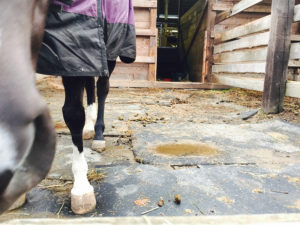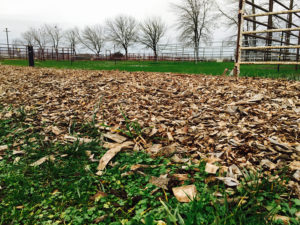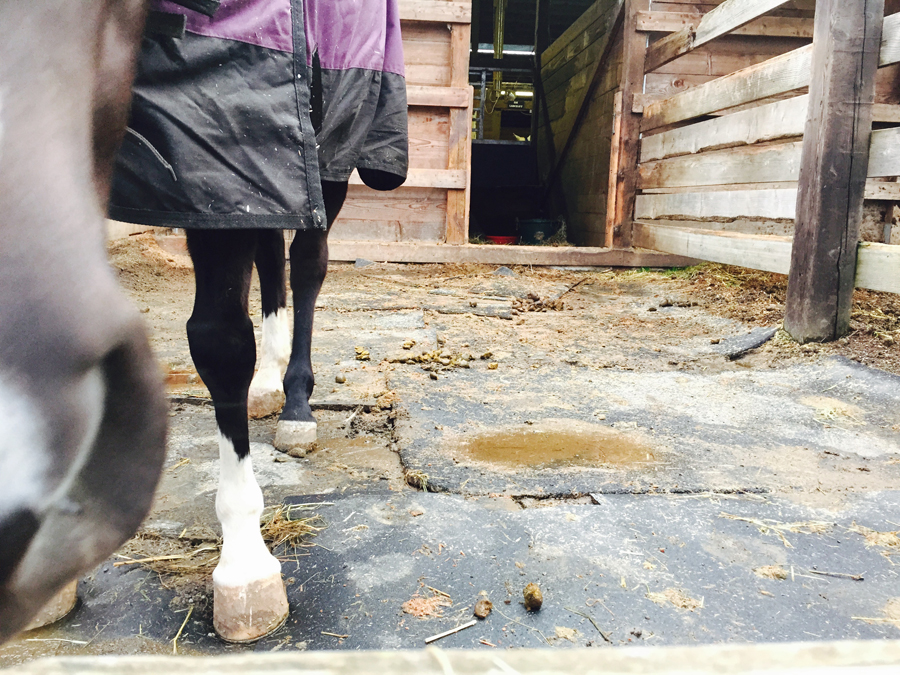The War on Mud: Comparing Gravel, Mats and Hog Fuel
by Theresa Rice
We’ve made it to March and are in the home stretch to spring! Hopefully, the manure piles have stopped freezing to the ground and your pastures are looking greener, but I’m guessing you’re still battling mud. This battle started back in late fall and maybe you’ve had some losses over winter—a boot, perhaps, sucked down deep in the mud flat of a turnout pen. With this month’s theme of barn and farm management, I thought now would be a great time to consider the footing around your facility. You can’t do much about the mud right now, but it’s a good time to think about a plan of action. If you’re like me, I’m so happy for the sunny days of spring and summer that I wait until the first falling leaves to wash my horse blankets, stock up on hay and prepare for winter. Don’t be like me: make a plan now for the next season of mud. Let’s compare three possible fixes.
Gravel is one of the most common surfaces to put down and one of my barn mates elected to have 3/8ths crushed gravel delivered into the run attached to her gelding’s stall. The gravel settles, drains well and stays relatively clean (she is also a fastidious stall cleaner). It does tend to spill outside of the run, but this could be controlled by placing wood around the base of the enclosure. She had 4 yards of the gravel delivered for $150. Most of the work took place prior to the delivery of the gravel in clearing out the old footing from the run (i.e. mud, sludge and manure).
 I opted to cover my gelding’s run in rubber mats. I did this over time, starting with just a couple mats at the entrance to the stall. Doing this over time took a little sting out of the cost as the entire run uses 8 mats and at $40 a mat that brings the cost to $320. The mats are easy to clean and my gelding’s hooves and fetlocks stay clean and dry. There are a few drawbacks to the mats. For one thing, if you don’t put the mats down while the ground is dry and instead set them over a wet and uneven surface, the first time your horse puts any weight on a soft spot he’s going to put his hoof right through that brand new mat. I’m speaking from experience, a really irritating experience. Additionally, the mats shift, so you have to readjust them back into place every month or so. The moving of the mats isn’t so bad in the summer, but in the winter they are in a vacuum lock relationship with the mud underneath and are both challenging and filthy to move. One last drawback is the tendency for water to pool in low spots. If you do not get the mats level, any dip will collect water, dissolving manure and making a disgusting soup.
I opted to cover my gelding’s run in rubber mats. I did this over time, starting with just a couple mats at the entrance to the stall. Doing this over time took a little sting out of the cost as the entire run uses 8 mats and at $40 a mat that brings the cost to $320. The mats are easy to clean and my gelding’s hooves and fetlocks stay clean and dry. There are a few drawbacks to the mats. For one thing, if you don’t put the mats down while the ground is dry and instead set them over a wet and uneven surface, the first time your horse puts any weight on a soft spot he’s going to put his hoof right through that brand new mat. I’m speaking from experience, a really irritating experience. Additionally, the mats shift, so you have to readjust them back into place every month or so. The moving of the mats isn’t so bad in the summer, but in the winter they are in a vacuum lock relationship with the mud underneath and are both challenging and filthy to move. One last drawback is the tendency for water to pool in low spots. If you do not get the mats level, any dip will collect water, dissolving manure and making a disgusting soup.
 There is also a wood-based option to help control mud, though I wouldn’t put it anywhere you need to pick manure. You can add wood chips (also referred to as hog fuel) to pathways and areas prone to mud for a reasonable cost. Sometimes you can get these wood chips donated from tree trimming services or utility companies. Hog fuel is also available for purchase for around $16 per cubic yard. The chips are large enough that they do not disintegrate into mud and allow for ample drainage. However, similar to the gravel, the material will tend to creep from its original placement.
There is also a wood-based option to help control mud, though I wouldn’t put it anywhere you need to pick manure. You can add wood chips (also referred to as hog fuel) to pathways and areas prone to mud for a reasonable cost. Sometimes you can get these wood chips donated from tree trimming services or utility companies. Hog fuel is also available for purchase for around $16 per cubic yard. The chips are large enough that they do not disintegrate into mud and allow for ample drainage. However, similar to the gravel, the material will tend to creep from its original placement.
I really thought I had the better setup with the mats in comparison to the gravel. However, when I take into consideration the cost and the drawbacks of the mats, I think the gravel is a better option. Remember, the key to your success with gravel relies on your removal of dirt before putting the gravel down. Whatever option you choose, I hope you find a reprieve from the mud in future winters to come.
Good luck and happy St. Patrick’s Day!

Theresa grew up riding horses off and on throughout her life, finally fulfilling her dream of horse ownership in 2012. She is currently working on her first novel, inspired by her time spent working on a guest ranch in Arizona where she met her husband. They married in 2012. When not writing, you can find her riding her half-Arabian gelding, Gangster, or chasing after her two German Shepherds. website: www.sassinboots.com

